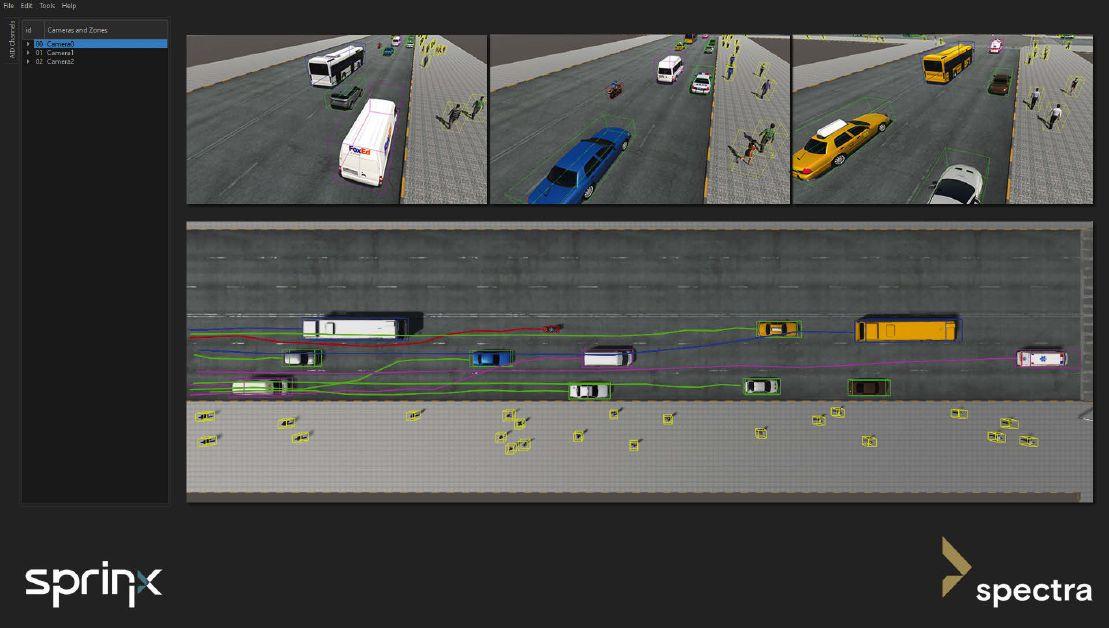
3 minute read
Multi-camera object tracking
The potential of multicamera object tracking
When you combine advances in AI with a multi-camera object tracking system, traffic monitoring becomes more accurate, more accessible and more reliable
Words | Andrea Galbiati, head of development, and Daniele Marzorati, head of innovation, Sprinx Technologies, Italy
Nowadays, most efforts in traffic management systems are focused on finding the best solution for detection and trajectory reconstruction using AI techniques. Many companies are engaged in improving deep learning models that will build algorithms more efficiently and that will be better able to generalize.
Traffic managers want a system capable of recognizing each type of vehicle, behaviour and anomaly, in a way that is not affected by weather, light or environmental conditions.
No matter what type of object these analytics are being trained to recognize, the approach is always based on the analysis of a single camera. Cameras are being treated as independent to one another and data collected by these cameras is isolated. One camera can only monitor a fixed view and there is no bridge to share the information. Further, data coming from a previous observation will not be propagated through to the next element in the chain of computation. This information will be lost.
Intra-camera correlation is usually manually carried out by traffic managers and operators, aided only by camera names, numbers and kilometres. Other times a certain degree of correlation is obtained by applying logical rules between cameras (i.e., suppressing alarms from the following camera if something was already detected by the previous one).
Exploiting unlimited potential
Sprinx believes that in the future, a surveillance system will be

considered as a whole. All information is valuable to simplify, accelerate, focus and pre-alert operators and traffic managers. With the exponential growth of IP video surveillance cameras, the opportunity to take advantage of the rich information that comes from multi-camera systems is immense.
Sprinx’s Spectra solution enables a network of connected cameras to be represented as a single entity. This video-based solution can identify and reconstruct the trajectory of all objects moving within the complex field of view of all the cameras. As such, it enables the detection of long-term vehicle behaviours and can make inferences throughout a vehicle’s journey.
Furthermore, information from previous observations can help to reduce noise in measurements, remove ambiguities in detection and improve tracking performance by focusing only on specific regions of interest.
When compared to traffic information based on single-camera, multi-camera systems are more challenging but, as previously outlined, they are highly accurate. Spectra enables monitoring of realworld scenarios, extracting features of the same object from several camera views, even if orientation and lighting conditions create variations.
Spectra overcomes spatialtemporal constraints to correctly track objects as they pass through the network of cameras. The system can even estimate the relative position of road lanes and surfaces between the different cameras. This means it knows on which camera an object will appear when exiting from another one. This enables the creation of graphs of connected lanes.
To reach these objectives, Spectra has been designed to tackle a variety of tasks: single-camera calibration, multi-camera calibration, multicamera tracking, data fusion (data association), global inference and data visualization.
Spectra processes live video streams to perform all of these tasks and obtain every object's trajectory through all of the cameras in the system. This is achieved despite problems such as occlusions, missed detections and view changes. Traffic managers can follow objects at single-camera and system-wide levels.
The key element of the system is the data association process, which deals with recognition and reidentification. This process enables the system to understand that it is observing the same object from different perspectives. Once Spectra has associated all of the data, it can start to integrate information into a common reference system. Spectra can then aggregate all of the raw data; some data will be duplicated, and some will be complimentary. The idea is to combine all of the data from both noisy and clean inputs to obtain a more consistent, accurate and precise output. The integrated information dashboard visualizes new information in an accessible way, making it easier for operators to understand and identify patterns and behaviours. ■
Above: Spectra processes live video streams to obtain every object’s trajectory through all of the cameras in the system











